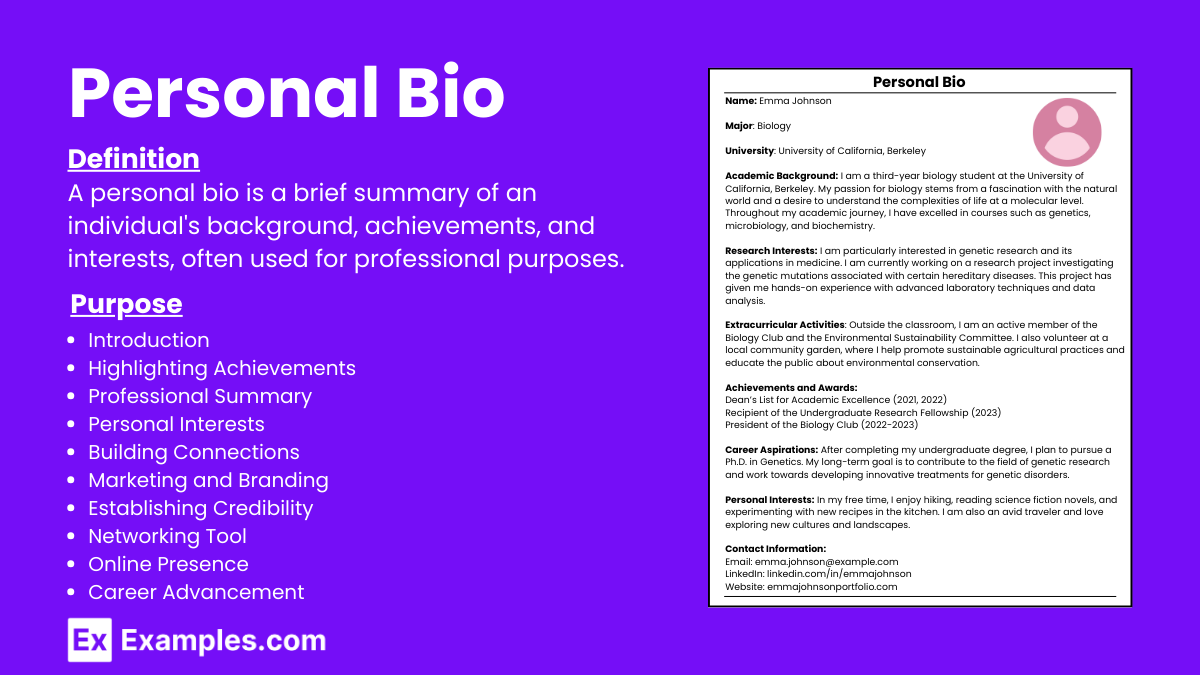21+ Personal Bio Examples
In today’s digital age, crafting a compelling personal bio has become essential for professionals in various fields. Whether you’re a job seeker, a freelancer, or a blogger, a well-written personal bio can leave a lasting impression on potential employers, clients, or readers. This article explores the world of personal bio examples and provides you with a comprehensive guide on how to create an impressive bio that stands out. From different document formats like Google Docs, Word, PDF, and Apple Pages to a range of creative options, we’ve got you covered with the ultimate collection of personal bio examples.
What is a Personal Bio?
A personal bio is a concise written summary that presents an individual’s background, accomplishments, skills, and aspirations in a professional manner. It serves as an introduction to showcase who you are and what you bring to the table. Personal bios come in various formats, including short bios, professional bios, and CV formats, and can be utilized for a range of purposes, such as job resumes, blog profiles, or social media profiles.
Personal Bio Format
Name: [Your Name]
Occupation: English Language Arts Teacher / Professor / Lecturer
Education:
- Master’s Degree in English
- Ph.D. in English (or specify the particular area of study)
Professional Experience: With over [number] years of experience in teaching English, I have worked with students of all grades and levels, from elementary to university. My teaching approach focuses on simplifying complex English concepts, making them accessible and engaging for all learners.
Teaching Philosophy: I believe in fostering a love for the English language through interactive and immersive learning experiences. My goal is to equip students with the skills and confidence needed to excel in their studies and beyond.
Areas of Expertise:
- English Grammar and Composition
- Literature Analysis
- Creative Writing
- ESL (English as a Second Language)
- Curriculum Development
Publications and Research:
- [Title of Publication], [Journal/Publisher], [Year]
- [Title of Publication], [Journal/Publisher], [Year]
- [Title of Publication], [Journal/Publisher], [Year]
Professional Affiliations:
- National Council of Teachers of English (NCTE)
- Modern Language Association (MLA)
- [Other relevant organizations]
Awards and Honors:
- [Name of Award], [Year]
- [Name of Award], [Year]
- [Name of Award], [Year]
Contact Information:
- Email: [your.email@example.com]
- LinkedIn: [Your LinkedIn Profile]
- Website: [Your Website]
Personal Interests: When I’m not teaching, I enjoy [hobby or interest], reading [genre] literature, and exploring new [activity].
Example of Personal Bio for Work
Michael Anderson
Senior Software Engineer
As a seasoned Senior Software Engineer with over a decade of experience in the tech industry, I excel in designing and implementing high-performance software solutions. My expertise spans across various programming languages, with a strong emphasis on developing scalable and secure applications.
Education:
M.S. in Computer Science – Stanford University, 2012
B.S. in Information Technology – University of California, Berkeley, 2010
Professional Experience:
Senior Software Engineer – Innovatech Solutions, New York, NY, 2018-PresentLed the development of a cloud-based application that improved data processing speed by 40%.
Implemented robust security protocols, reducing system vulnerabilities by 30%.
Collaborated with cross-functional teams to streamline project workflows, resulting in a 25% increase in productivity.
Software Engineer – TechnoSoft Inc., Boston, MA, 2012-2018Developed and maintained multiple web applications, enhancing user experience and functionality.
Played a key role in migrating legacy systems to modern platforms, improving operational efficiency.
Skills:
Proficient in Python, Java, and C++
Expertise in cloud computing, cybersecurity, and agile methodologies
Strong analytical and problem-solving abilities
Accomplishments:
Certified Information Systems Security Professional (CISSP)
Recipient of the 2020 Excellence in Innovation Award
Personal Interests:
Passionate about artificial intelligence and machine learning
Avid chess player and marathon runner
Contact Information:
Email: michael.anderson@example.com
LinkedIn: linkedin.com/in/michaelanderson
Phone: (555) 123-4567
Example of Personal Bio for Students
Name: Emma Johnson
Major: Biology
University: University of California, Berkeley
Academic Background: I am a third-year biology student at the University of California, Berkeley. My passion for biology stems from a fascination with the natural world and a desire to understand the complexities of life at a molecular level. Throughout my academic journey, I have excelled in courses such as genetics, microbiology, and biochemistry.
Research Interests: I am particularly interested in genetic research and its applications in medicine. I am currently working on a research project investigating the genetic mutations associated with certain hereditary diseases. This project has given me hands-on experience with advanced laboratory techniques and data analysis.
Extracurricular Activities: Outside the classroom, I am an active member of the Biology Club and the Environmental Sustainability Committee. I also volunteer at a local community garden, where I help promote sustainable agricultural practices and educate the public about environmental conservation.
Achievements and Awards:
Dean’s List for Academic Excellence (2021, 2022)
Recipient of the Undergraduate Research Fellowship (2023)
President of the Biology Club (2022-2023)
Career Aspirations: After completing my undergraduate degree, I plan to pursue a Ph.D. in Genetics. My long-term goal is to contribute to the field of genetic research and work towards developing innovative treatments for genetic disorders.
Personal Interests: In my free time, I enjoy hiking, reading science fiction novels, and experimenting with new recipes in the kitchen. I am also an avid traveler and love exploring new cultures and landscapes.
Contact Information:
Email: emma.johnson@example.com
LinkedIn: linkedin.com/in/emmajohnson
Website: emmajohnsonportfolio.com
Example of Personal Bio for College
Name: Michael Anderson
Major: Computer Science
University: Stanford University
Academic Background: I am a second-year Computer Science student at Stanford University, where I have developed a strong foundation in programming, algorithms, and data structures. My academic journey has been marked by a passion for solving complex problems and a commitment to continuous learning.
Research Interests: I have a keen interest in artificial intelligence and machine learning. Currently, I am part of a research team working on developing machine learning algorithms to improve predictive analytics in healthcare. This experience has provided me with practical knowledge of AI applications and data analysis.
Extracurricular Activities: Beyond academics, I am actively involved in the Computer Science Club, where I help organize coding workshops and hackathons. I also volunteer as a coding mentor for a local high school, helping students develop their programming skills.
Achievements and Awards:
Dean’s List for Academic Excellence (2022)
Winner of the Stanford Hackathon (2023)
Vice President of the Computer Science Club (2023-2024)
Career Aspirations: After earning my undergraduate degree, I plan to pursue a Master’s in Artificial Intelligence. My career goal is to work as an AI researcher, developing innovative solutions that can address real-world challenges, particularly in the field of healthcare.
Personal Interests: In my spare time, I enjoy playing chess, hiking, and working on personal coding projects. I am also a tech enthusiast who loves staying updated with the latest advancements in technology and gadgets.
Contact Information:
Email: michael.anderson@example.com
LinkedIn: linkedin.com/in/michaelanderson
GitHub: github.com/michaelanderson
Example of Personal Bio for Professionals
Name: Olivia Martinez
Professional Title: Marketing Manager
Company: ABC Marketing Solutions
Professional Background: I am a Marketing Manager at ABC Marketing Solutions with over seven years of experience in developing and executing comprehensive marketing strategies. My expertise lies in digital marketing, content creation, and brand management. I have successfully led campaigns that increased brand awareness and drove customer engagement, resulting in a significant boost in sales.
Education:
Master’s Degree in Marketing, University of Southern California
Bachelor’s Degree in Business Administration, University of Texas at Austin
Areas of Expertise:
Digital Marketing
Content Strategy
Social Media Marketing
Brand Management
Market Analysis
Professional Achievements:
Developed a social media campaign that increased client engagement by 45%
Managed a team that achieved a 30% increase in organic search traffic in one year
Awarded the “Top Marketer of the Year” by the Marketing Association of America in 2022
Professional Affiliations:
Member of the American Marketing Association (AMA)
Certified Digital Marketing Professional (CDMP)
Career Aspirations: I aspire to continue growing in the field of marketing, with a particular focus on integrating new technologies and trends to drive innovation. My long-term goal is to assume a leadership role where I can mentor emerging marketing professionals and shape the strategic direction of a forward-thinking company.
Personal Interests: Outside of work, I enjoy photography, traveling, and exploring new cuisines. I am also passionate about volunteering and frequently participate in community service projects aimed at promoting literacy and education.
Contact Information:
Email: olivia.martinez@example.com
LinkedIn: linkedin.com/in/oliviamartinez
Website: oliviamartinezmarketing.com
Example of Personal Bio for Business
Name: James Thompson
Professional Title: Founder and CEO
Company: Thompson Tech Solutions
Professional Background: I am the Founder and CEO of Thompson Tech Solutions, a technology consulting firm specializing in IT infrastructure and cybersecurity. With over 15 years of experience in the tech industry, I have built a reputation for delivering innovative solutions that drive business growth and enhance operational efficiency. My leadership has guided our company to become a trusted partner for clients across various industries.
Education:
MBA in Information Technology Management, Massachusetts Institute of Technology (MIT)
Bachelor’s Degree in Computer Science, University of California, Berkeley
Areas of Expertise:
IT Infrastructure
Cybersecurity
Cloud Computing
Digital Transformation
Strategic Planning
Professional Achievements:
Successfully led a team to implement a cybersecurity framework that reduced data breaches by 40%
Grew Thompson Tech Solutions from a startup to a multi-million-dollar company within five years
Awarded “Tech Innovator of the Year” by the National Technology Association in 2022
Professional Affiliations:
Member of the Information Systems Audit and Control Association (ISACA)
Certified Information Systems Security Professional (CISSP)
Career Aspirations: My goal is to continue expanding Thompson Tech Solutions into new markets and technological frontiers. I aim to lead the industry in developing advanced cybersecurity measures and IT solutions that address the evolving challenges faced by businesses today.
Personal Interests: Outside of work, I am an avid marathon runner and enjoy participating in tech meetups and conferences. I am also committed to giving back to the community through mentorship programs and supporting STEM education initiatives.
Contact Information:
Email: james.thompson@example.com
LinkedIn: linkedin.com/in/jamesthompson
Website: thompsontechsolutions.com
Example of Personal Bio for Job
Name: Sarah Thompson
Professional Title: Senior Software Engineer
Company: XYZ Tech Solutions
Professional Background: I am a Senior Software Engineer at XYZ Tech Solutions with over eight years of experience in software development and project management. I specialize in developing scalable web applications and leading cross-functional teams to deliver high-quality software solutions. My expertise lies in Java, Python, and cloud computing technologies.
Education:
Master’s Degree in Computer Science, Stanford University
Bachelor’s Degree in Information Technology, University of California, Berkeley
Areas of Expertise:
Full-Stack Web Development
Cloud Computing
Agile Project Management
Software Architecture
Data Analysis
Professional Achievements:
Led a team that developed a cloud-based inventory management system, increasing operational efficiency by 35%
Received the “Employee of the Year” award at XYZ Tech Solutions in 2022
Published a paper on microservices architecture in the Journal of Software Engineering
Professional Affiliations:
Member of the Association for Computing Machinery (ACM)
Certified ScrumMaster (CSM)
Career Aspirations: My goal is to continue advancing in the field of software engineering, focusing on innovative solutions in cloud computing and AI integration. I aspire to take on more leadership roles and contribute to cutting-edge projects that drive technological advancement.
Personal Interests: Outside of work, I enjoy hiking, coding personal projects, and participating in hackathons. I am also passionate about mentoring young engineers and volunteering at local coding bootcamps.
Contact Information:
Email: sarah.thompson@example.com
LinkedIn: linkedin.com/in/sarahthompson
GitHub: github.com/sarahthompson
Examples of Personal Bio for Blog
1. Lifestyle Blog
Name: Jessica Martinez
About Me: Hi there! I’m Jessica Martinez, the creator behind “Living Well with Jessica.” As a lifestyle blogger, I share my passion for healthy living, mindful practices, and all things that make life a little brighter. With a background in nutrition and wellness coaching, I aim to inspire my readers to live their best lives through simple, sustainable changes.
What You’ll Find on My Blog:
Healthy Recipes: Delicious and nutritious recipes that are easy to make.
Wellness Tips: Practical advice for mental and physical well-being.
DIY Projects: Fun and creative projects to beautify your home and life.
Travel Guides: Tips and itineraries for exploring new places on a budget.
Why I Blog: I started this blog to connect with like-minded individuals who are passionate about living well. My goal is to create a supportive community where we can share ideas, motivate each other, and celebrate our successes together.
Contact Information:
Email: jessica.martinez@example.com
Instagram: @livingwellwithjessica
Facebook: facebook.com/livingwellwithjessica
Personal Interests: When I’m not blogging, you can find me practicing yoga, hiking with my dog, or experimenting with new smoothie recipes.
2 Travel Blog
Name: Alex Kim
About Me: Welcome to “Wanderlust with Alex”! I’m Alex Kim, a travel enthusiast with a penchant for adventure and cultural exploration. With over 50 countries stamped in my passport, I aim to inspire and guide fellow travelers to discover the beauty and diversity of our world.
What You’ll Find on My Blog:
Travel Guides: Comprehensive guides to must-see destinations and hidden gems.
Budget Travel Tips: Strategies for making the most of your travels without breaking the bank.
Cultural Insights: Stories and insights into the traditions and lifestyles of different cultures.
Photography: Stunning visuals that capture the essence of each location I visit.
Why I Blog: I believe that travel is one of the most enriching experiences one can have. Through my blog, I hope to share my adventures and help others embark on their own journeys, equipped with the knowledge and confidence to explore the world.
Contact Information:
Email: alex.kim@example.com
Twitter: @wanderlustalex
YouTube: youtube.com/wanderlustwithalex
Personal Interests: When I’m not on the road, I enjoy cooking international cuisine, learning new languages, and hiking in nature reserves.
3. Food Blog
Name: Emily Rodriguez
About Me: Hello! I’m Emily Rodriguez, a foodie and recipe developer passionate about plant-based cooking. Based in LA, I love creating and sharing delicious, healthy recipes. Follow my blog for daily culinary inspiration and tips on living a healthier lifestyle.
What You’ll Find on My Blog:
Plant-Based Recipes: Creative and tasty recipes that are good for you and the planet.
Cooking Tips: Practical advice to make cooking fun and easy.
Food Photography: Beautiful images to inspire your next meal.
Restaurant Reviews: Honest reviews of plant-based eateries.
Why I Blog: I started this blog to share my love for food and healthy living. My goal is to show that plant-based cooking can be simple, delicious, and accessible to everyone.
Contact Information:
Email: emily.rodriguez@example.com
Instagram: @delishbyemily
Pinterest: pinterest.com/delishbyemily
Personal Interests: When I’m not in the kitchen, I love hiking, practicing yoga, and exploring new restaurants.
4. Fashion Blog
Name: Mia Thompson
About Me: Hi! I’m Mia Thompson, a fashion enthusiast and beauty lover from NYC. I believe in making high fashion accessible to everyone. Follow my blog for daily outfit inspirations, beauty hacks, and fashion tips.
What You’ll Find on My Blog:
Style Tips: Advice on how to create chic and versatile outfits for any occasion.
Beauty Reviews: Honest reviews of the latest beauty products and trends.
Fashion News: Updates on runway shows, designer collections, and industry events.
DIY Fashion: Creative projects to personalize your wardrobe and accessories.
Why I Blog: Fashion is a powerful form of self-expression, and I want to help my readers find their unique style. Through my blog, I share my passion for fashion and provide practical tips to make high style accessible to everyone.
Contact Information:
Email: mia.thompson@example.com
Instagram: @chicstyleswithmia
Pinterest: pinterest.com/chicstyleswithmia
Personal Interests: Apart from blogging, I love sketching new designs, exploring vintage shops, and attending fashion shows.
5. Tech Blog
Name: Kevin Nguyen
About Me: Hey there! I’m Kevin Nguyen, a tech enthusiast and gadget reviewer from Silicon Valley. I love exploring the latest in tech and innovation. Follow
my blog for reviews, tech news, and insights on the coolest gadgets.
What You’ll Find on My Blog:
Tech Reviews: In-depth reviews of the latest gadgets and technology.
Tech News: Updates on the newest advancements in the tech world.
How-To Guides: Step-by-step guides to help you make the most of your tech.
Opinion Pieces: My take on the latest trends and innovations in technology.
Why I Blog: I started this blog to share my passion for technology and to help others stay informed about the latest trends and products. My goal is to make technology accessible and understandable for everyone.
Contact Information:
Email: kevin.nguyen@example.com
Twitter: @techwithkevin
YouTube: youtube.com/techwithkevin
Personal Interests: When I’m not blogging, you can find me playing video games, building custom PCs, and attending tech conferences.
Examples of Personal Bio for Instagram
1. Fitness Influencer
Name: Sarah Williams
Username: @fitwithsarah
Bio: 🏋️♀️ Fitness Enthusiast | 🥗 Nutrition Advocate | 💪 Helping You Achieve Your Best Self
🏅 Certified Personal Trainer | 📍 NYC
🌟 Sharing workouts, healthy recipes, and motivation
📩 DM for collabs & training programs
⬇️ Check out my latest workout routine!
2. Travel Influencer
Name: Alex Kim
Username: @wanderlustalex
Bio: ✈️ Travel Addict | 📸 Photography Buff | 🌍 Exploring the World One City at a Time
📍 Currently in: Bali
📝 Travel tips, guides & hidden gems
💌 Collabs & inquiries: alex@example.com
🎥 New travel vlog up now! ⬇️
3. Food Blogger
Name: Emily Rodriguez
Username: @delishbyemily
Bio: 🍽️ Foodie | 🥘 Recipe Developer | 🌱 Plant-Based Enthusiast
🍴 Sharing delicious, healthy recipes and food tips
📍 LA
📸 Tag #DelishByEmily to be featured!
📩 Contact: emily@example.com
⬇️ Discover my favorite vegan dessert!
4. Fashion Influencer
Name: Mia Thompson
Username: @stylebymia
Bio: 👗 Fashionista | 💄 Beauty Lover | 🌟 NYC Based
📸 Daily OOTD | 💅 Beauty Hacks | 👠 Fashion Tips
✨ Making high fashion accessible
💌 Collabs & PR: mia@example.com
⬇️ Shop my looks!
5. Lifestyle Influencer
Name: Liam Parker
Username: @livingwithliam
Bio: 🌟 Lifestyle Blogger | 🏡 Home Decor | 📚 Book Lover
📝 Sharing tips on home decor, wellness, and personal growth
📍 SF Bay Area
💌 For partnerships: liam@example.com
⬇️ New blog post: 5 Ways to Cozy Up Your Home!
Examples of Personal Bio for Facebook
1. Fitness Trainer
Name: Sarah Williams
Bio: Welcome to my fitness journey! I’m Sarah Williams, a certified personal trainer and nutrition advocate based in NYC. My mission is to inspire and empower you to achieve your best self through fitness and healthy living. Follow me for workout tips, nutritious recipes, and daily motivation. Let’s get fit together!
Interests:
Fitness Training
Nutrition
Healthy Living
Motivation
Contact Information:
Email: sarah.williams@example.com
2. Travel Blogger
Name: Alex Kim
Bio: Hi there! I’m Alex Kim, a travel addict and photography buff exploring the world one city at a time. Currently soaking up the sun in Bali. I share travel tips, guides, and hidden gems from my adventures. Join me on my journey and discover new destinations!
Interests:
Traveling
Photography
Cultural Exploration
Adventure
Contact Information:
Email: alex.kim@example.com
3. Food Blogger
Name: Emily Rodriguez
Bio: Hello! I’m Emily Rodriguez, a foodie and recipe developer passionate about plant-based cooking. Based in LA, I love creating and sharing delicious, healthy recipes. Follow my page for daily culinary inspiration and tips on living a healthier lifestyle.
Interests:
Cooking
Plant-Based Recipes
Healthy Living
Food Photography
Contact Information:
Email: emily.rodriguez@example.com
4. Fashion Influencer
Name: Mia Thompson
Bio: Hi! I’m Mia Thompson, a fashion enthusiast and beauty lover from NYC. I believe in making high fashion accessible to everyone. Follow me for daily outfit inspirations, beauty hacks, and fashion tips. Let’s make the world our runway!
Interests:
Fashion
Beauty
Styling Tips
Trend Analysis
Contact Information:
Email: mia.thompson@example.com
5. Lifestyle Blogger
Name: Liam Parker
Bio: Welcome! I’m Liam Parker, a lifestyle blogger based in the SF Bay Area. I share tips on home decor, wellness, and personal growth. My goal is to help you create a more fulfilling and cozy life. Follow my page for daily inspiration and practical advice.
Interests:
Home Decor
Wellness
Personal Growth
Book Reviews
Contact Information:
Email: liam.parker@example.com
More Samples & Templates for Personal Bio
1. Personal Bio Example
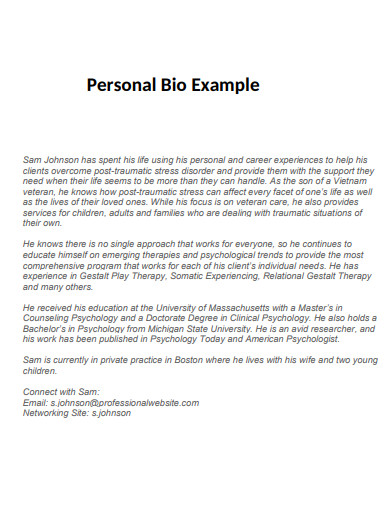
myperfectwords.com
2. Personal Bio Example
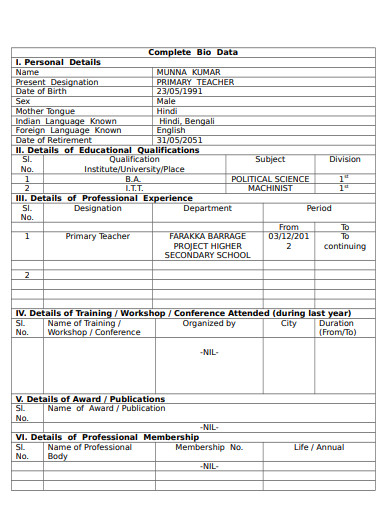
fbp.gov.in
3. Sample Personal Bio Example
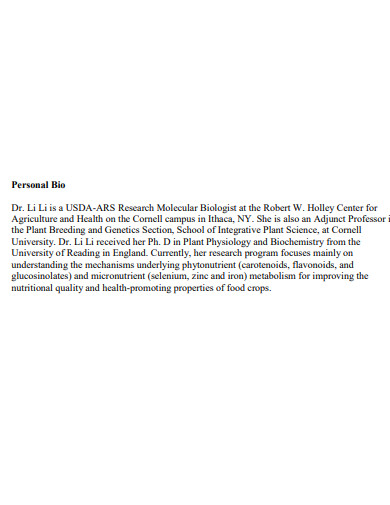
ars.usda.gov
4. Personal Short Bio Example

nbna.org
5. Student Personal Bio Example
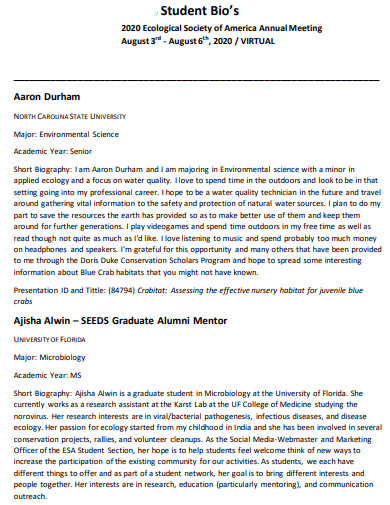
harvardforest.fas.harvard.edu
6. High School Personal Bio Example
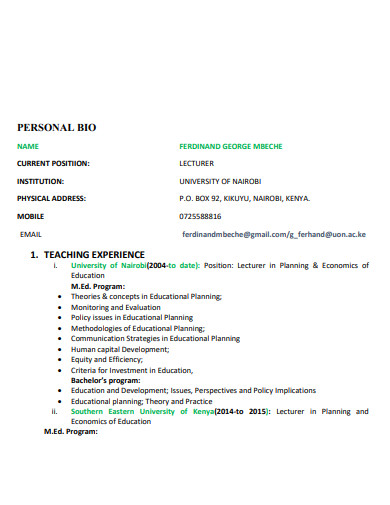
profiles.uonbi.ac.ke
Purpose of a Personal Bio
A personal bio serves multiple purposes, offering a concise and engaging summary of your professional and personal background. Here are the key purposes of a personal bio:
1. Introduce Yourself
A personal bio provides a snapshot of who you are, offering a quick introduction to your professional and personal identity.
2. Establish Credibility
By outlining your qualifications, experience, and achievements, a personal bio establishes your credibility in your field. It highlights your expertise and professional journey.
3. Build a Personal Brand
A well-crafted bio helps to build and reinforce your personal brand. It communicates your values, passions, and unique attributes, differentiating you from others.
4. Connect with Your Audience
A personal bio helps to connect with your audience on a personal level. It can include personal interests and hobbies, making you more relatable and approachable.
5. Professional Networking
In professional settings, a bio is essential for networking. It provides colleagues, potential employers, and collaborators with a clear understanding of your background and professional interests.
6. Digital Presence
For online platforms such as social media, blogs, and websites, a personal bio enhances your digital presence. It gives visitors a quick overview of who you are and what you do.
7. Highlight Achievements
A bio is an opportunity to showcase your achievements and accolades. It allows you to highlight significant milestones in your career, awards, and recognitions.
8. Provide Contact Information
Including contact details in your bio ensures that readers can easily get in touch with you for professional inquiries, collaborations, or networking opportunities.
Where to Display Your Personal Bio
Your personal bio is a versatile tool that can enhance your professional and personal presence across various platforms. Here are key places to display your personal bio:
1. Professional Website
- About Page: Include a detailed bio on the “About” or “Bio” page of your professional website. This helps visitors understand your background, expertise, and what you offer.
- Homepage: A shorter version or summary of your bio can be displayed on the homepage to immediately introduce yourself to visitors.
2. Social Media Profiles
- LinkedIn: Use your bio in the “About” section to summarize your professional background, skills, and achievements. This is crucial for networking and job opportunities.
- Facebook: On your personal or business page, include your bio in the “About” section to provide a clear picture of your professional and personal interests.
- Instagram: A concise version of your bio should go in your profile description, highlighting key aspects of your identity and interests.
- Twitter: Use a brief, impactful version of your bio in your Twitter profile to quickly communicate who you are and what you do.
3. Resume and Cover Letter
- Resume: Include a professional summary at the top of your resume that encapsulates your bio, focusing on your career highlights and key skills.
- Cover Letter: Use elements of your bio to introduce yourself and explain your qualifications and interests in the cover letter.
4. Professional Networking Sites
- Industry-Specific Platforms: Use your bio on industry-specific networking sites to connect with professionals in your field.
- Professional Associations: Display your bio on profiles for any professional associations or organizations you belong to.
5. Speaking Engagements and Conferences
- Event Websites: Provide your bio for the speaker section on event websites to introduce yourself to attendees.
- Program Materials: Include your bio in conference programs or handouts to give the audience a background of your expertise.
6. Blog and Guest Posts
- Author Bio: Add your bio at the end of blog posts or articles you write, either on your own blog or as a guest contributor. This establishes credibility and directs readers to your other work.
7. Email Signature
- Email Footer: Incorporate a brief version of your bio in your email signature to provide recipients with a quick overview of who you are and your professional role.
8. Online Portfolios
- Portfolio Website: Display a detailed bio on your portfolio website to provide context for your work and background.
- Creative Platforms: Use your bio on platforms like Behance, Dribbble, or GitHub to introduce yourself to potential clients or collaborators.
9. Business Documents and Proposals
- Proposals: Include your bio in business proposals to introduce yourself to potential clients or partners.
- Brochures and Flyers: Use a concise version of your bio in marketing materials to provide context and build trust.
10. Networking and Professional Profiles
- Business Cards: Include a brief version of your bio on the back of your business cards.
- Professional Directories: List your bio in professional directories to make it easy for others to find and learn about you.
What to Include in a Personal Bio?
A well-crafted personal bio provides a comprehensive and engaging summary of your professional and personal background. Here are the essential elements to include in your personal bio:
1. Full Name
- Clearly state your full name at the beginning of the bio.
2. Professional Title
- Include your current job title or professional role to immediately convey your primary occupation.
3. Professional Background
- Summarize your career path, including your current role and previous positions. Highlight significant experiences that showcase your expertise.
4. Education
- Mention relevant educational qualifications and institutions you attended. Include degrees, certifications, and any notable academic achievements.
5. Areas of Expertise
- Highlight your key skills and areas of specialization. This helps readers understand your professional strengths and what you can offer.
6. Achievements and Awards
- Include any notable achievements, awards, and recognitions you have received. This establishes your credibility and showcases your accomplishments.
7. Professional Affiliations
- List any professional organizations or associations you are a member of. This can demonstrate your involvement and commitment to your field.
8. Personal Interests
- Share a few personal interests or hobbies to add a human touch to your bio. This makes you more relatable and approachable.
9. Contact Information
- Provide ways for readers to contact you, such as email, social media handles, or website links. This makes it easy for potential collaborators or clients to reach out.
10. Call to Action (Optional)
- If appropriate, include a call to action, such as inviting readers to connect with you on LinkedIn, visit your website, or follow you on social media.
Personal Bio vs. Resume
| Aspect | Personal Bio | Resume |
|---|---|---|
| Purpose | Narrative overview of personal and professional life | Detailed professional experience, education, and skills |
| Format | Narrative, often in paragraphs | Structured, with bullet points and sections |
| Length | Typically 1-2 paragraphs or short sections | Usually 1-2 pages |
| Tone | Personal and engaging | Professional and concise |
| Content | Career overview, personal interests, achievements | Detailed job history, education, skills, certifications |
| Usage | Online profiles, speaking engagements, author bios | Job applications, professional networking |
| Personal Information | Includes personal interests and hobbies | Focuses on professional achievements and qualifications |
| Audience | General audience, potential collaborators, clients | Hiring managers, recruiters, professional connections |
| Customization | General, suitable for various contexts | Highly customized for specific job applications |
| Detail Level | High-level overview | Detailed, with specific dates and responsibilities |
How to Write a Personal Bio
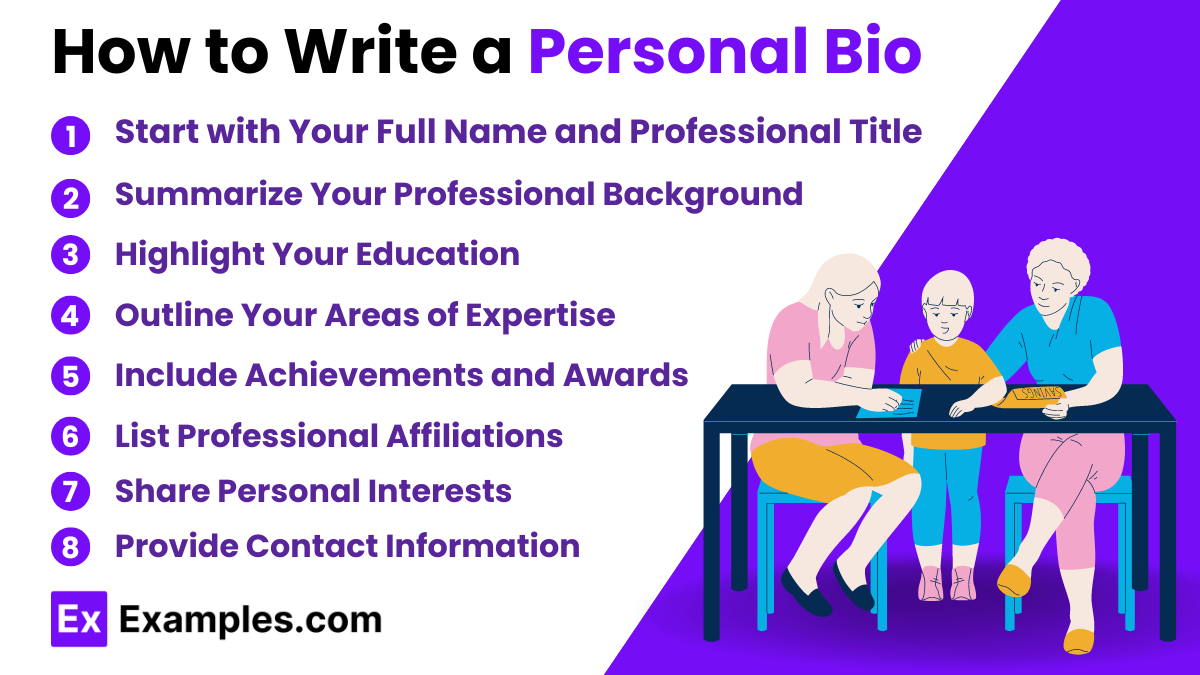
Writing a personal bio involves highlighting your personal and professional journey in an engaging and concise manner. Here’s a step-by-step guide to help you craft an effective personal bio:
1. Start with Your Full Name and Professional Title
Begin your bio with your full name and your current professional title. This immediately tells the reader who you are and what you do.
Example: Name: Dr. Emily Harris
Professional Title: English Language Arts Professor
2. Summarize Your Professional Background
Provide a brief summary of your career path, including your current role and previous significant positions. Highlight your expertise and areas of specialization.
Example: Dr. Emily Harris has over 15 years of experience in higher education, dedicating her career to teaching and inspiring students in the field of English Language Arts. She has taught a wide range of courses, including Shakespearean literature, modern American poetry, and creative writing, at both undergraduate and graduate levels.
3. Highlight Your Education
Mention your relevant educational qualifications, degrees, and the institutions you attended. This adds credibility to your professional background.
Example: Education:
- Ph.D. in English Literature, University of California, Berkeley
- Master’s Degree in English, University of Chicago
4. Outline Your Areas of Expertise
List your key skills and areas of specialization. This helps readers understand your professional strengths and what you can offer.
Example: Areas of Expertise:
- English Literature
- Literary Criticism
- Creative Writing
- Rhetoric and Composition
- Curriculum Development
5. Include Achievements and Awards
Mention any notable achievements, awards, and recognitions you have received. This establishes your credibility and showcases your accomplishments.
Example: Achievements and Awards:
- Excellence in Teaching Award, University of California, Berkeley, 2020
- Best Research Paper Award, Modern Language Review, 2019
6. List Professional Affiliations
Include any professional organizations or associations you are a member of. This demonstrates your involvement and commitment to your field.
Example: Professional Affiliations:
- National Council of Teachers of English (NCTE)
- Modern Language Association (MLA)
7. Share Personal Interests
Add a few personal interests or hobbies to make your bio more relatable and humanize yourself to the reader.
Example: Outside of her academic career, Dr. Harris enjoys reading historical novels, traveling to literary landmarks, and participating in community theater.
8. Provide Contact Information
Include ways for readers to contact you, such as email, social media handles, or website links. This makes it easy for potential collaborators or clients to reach out.
Example: Contact Information:
- Email: emily.harris@example.com
- LinkedIn: linkedin.com/in/emilyharris
- Website: emilyharris.com
Why is a personal bio important?
A personal bio provides a concise summary of your professional and personal life, helping others quickly understand who you are and what you do.
How long should a personal bio be?
A personal bio should typically be 1-2 paragraphs for brief profiles or 3-4 paragraphs for more detailed ones, balancing brevity and comprehensiveness.
What tone should I use in my personal bio?
Use a tone that is professional yet approachable. Tailor the tone to fit the platform, whether it’s more formal for LinkedIn or casual for social media.
Should I include personal interests in my bio?
Yes, including personal interests humanizes your bio and makes you more relatable, providing a fuller picture of who you are beyond your professional life.
How often should I update my personal bio?
Update your personal bio whenever there are significant changes in your professional life, such as new job roles, achievements, or completed projects.
Can I use the same bio on different platforms?
Yes, but tailor each bio slightly to fit the specific audience and platform, ensuring relevance and appropriateness for each context.
How do I make my bio engaging?
Use a clear structure, highlight unique aspects of your career and personality, and avoid jargon. Write in a way that is interesting and easy to read.
Should I mention my achievements and awards?
Yes, mentioning achievements and awards adds credibility and showcases your expertise, helping to establish your professional reputation.
What should I avoid in a personal bio?
Avoid overly technical language, excessive self-promotion, and irrelevant personal details. Keep it concise, relevant, and professional.
How do I end my personal bio?
End your bio with a call to action or contact information, encouraging readers to connect with you or visit your website for more information.



